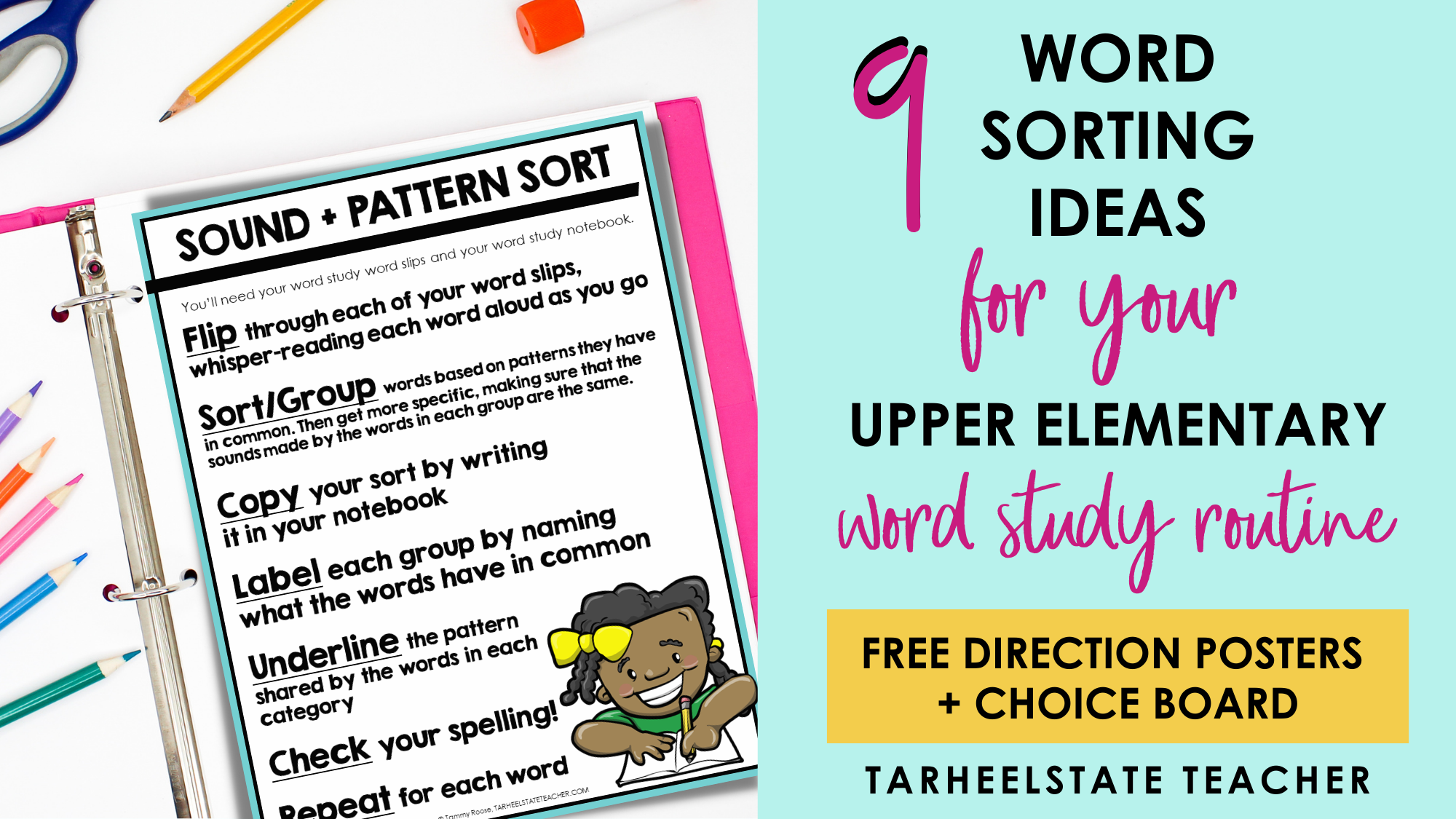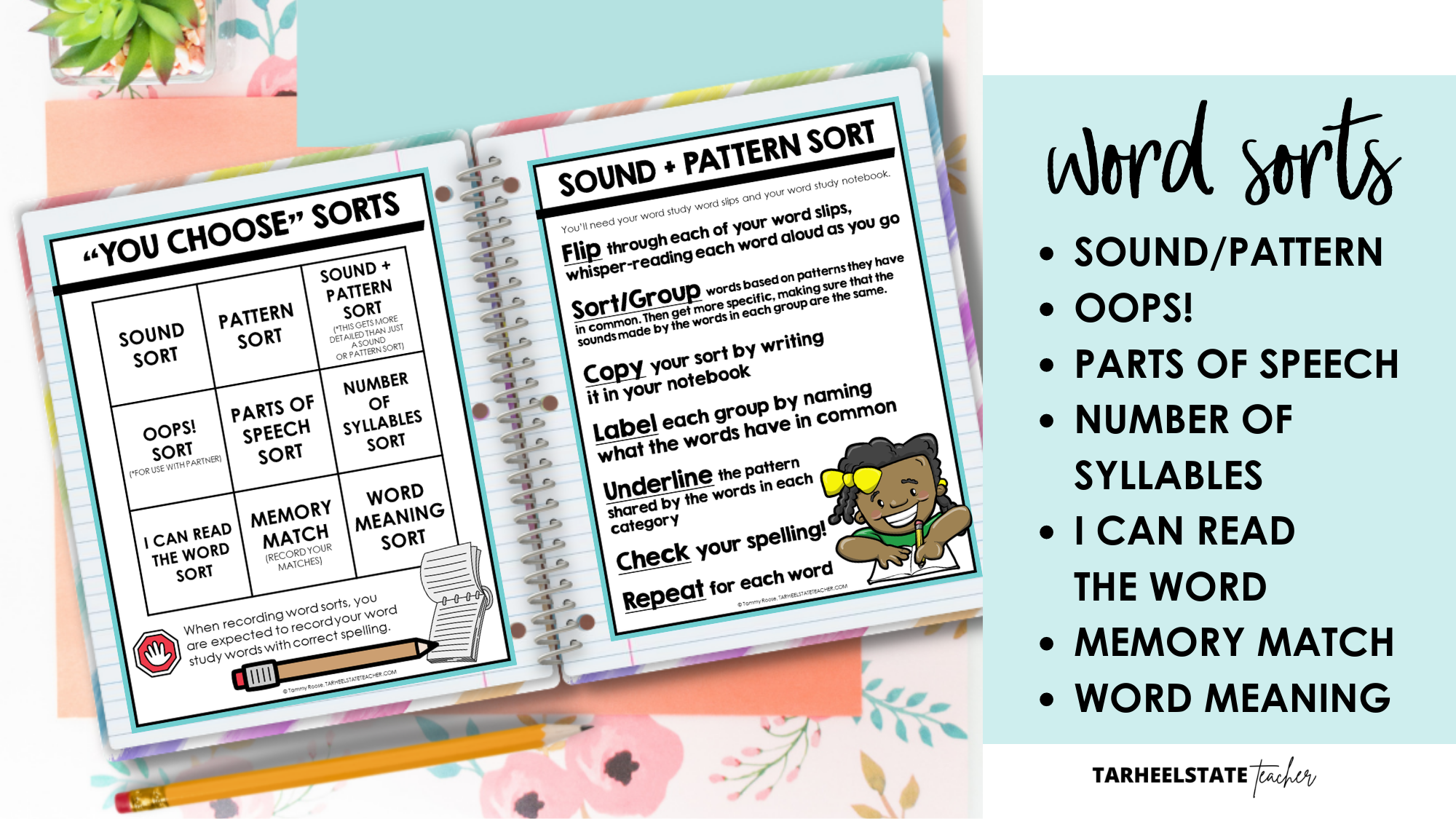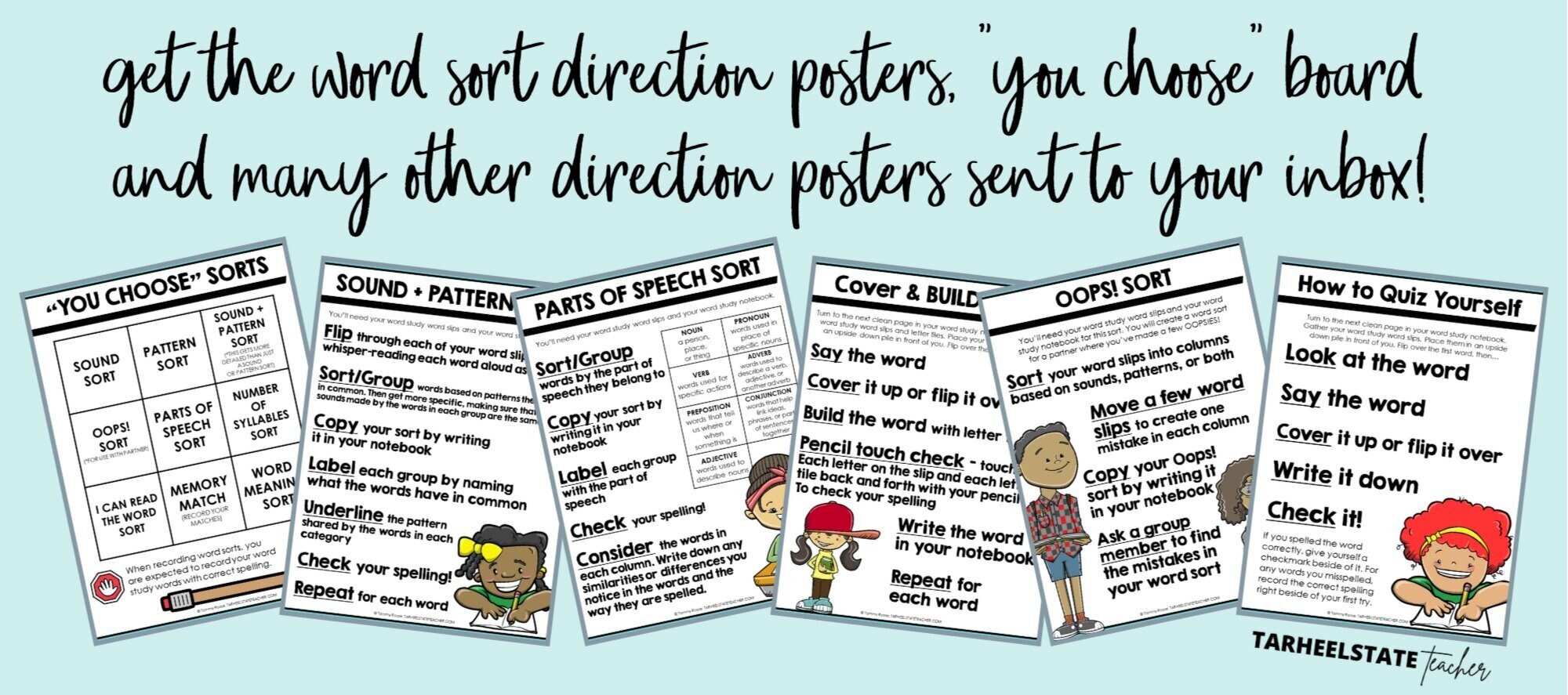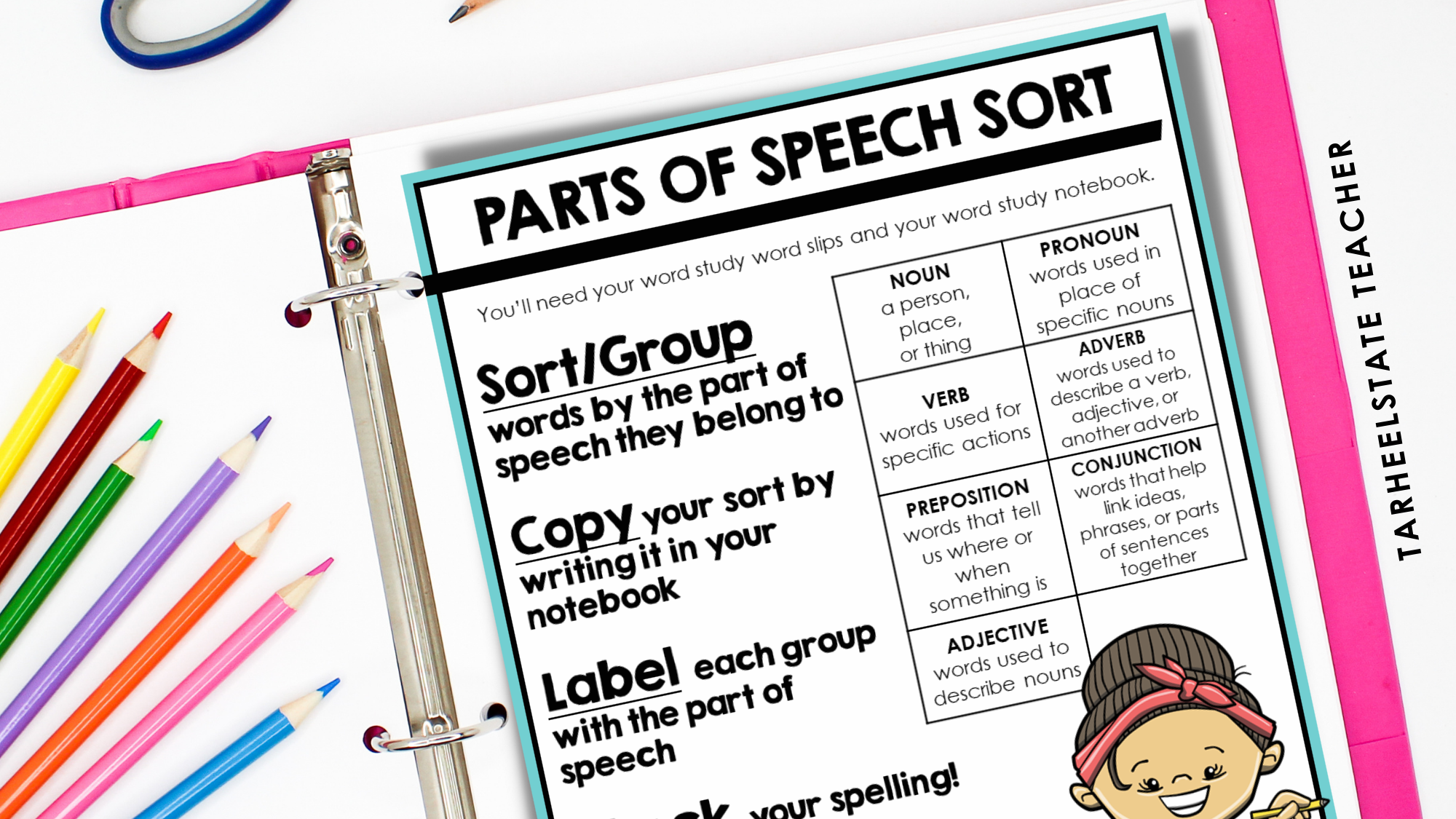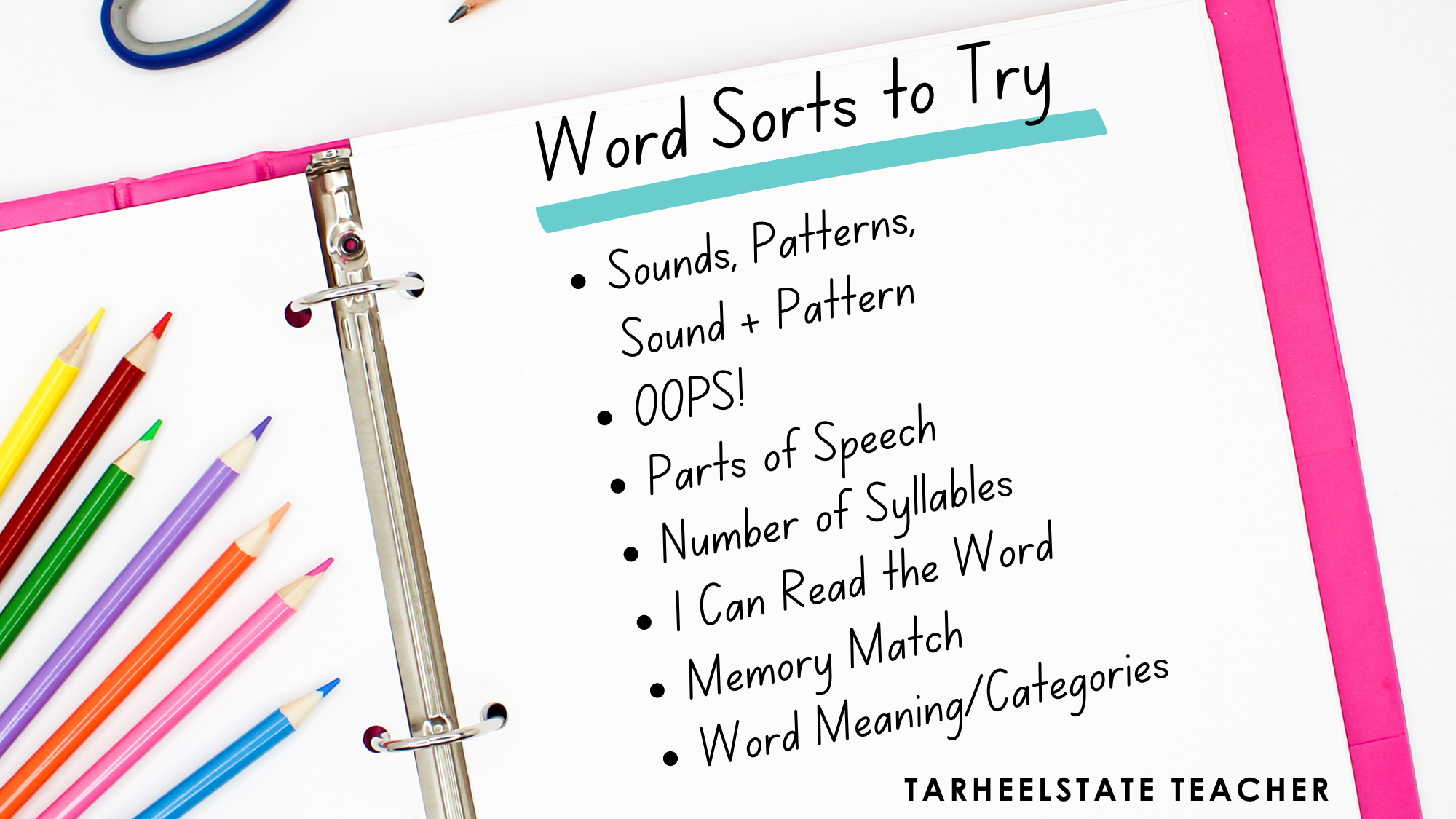9 Ideas for Word Sorts + Free How to Sort Posters
Some say that word sorts are the heart of a word study program…I prefer to think of it as one component in an array of activities that help our upper elementary students to better understand and spell words. As students complete different sorts, they can think about the spelling patterns and sounds they see and hear, recognize “oddballs” or words that don’t seem to fit in with similar words, and we as teachers can gain better insight into their mastery of the word study concepts and the words’ meanings. Today, I’ve got 9 types of word sorts that you can use with your students. Don’t miss your chance to grab the free PDF of direction posters and a “You Choose” word sort choice board that will help you implement word sorting routines with your students.
Confession…for years, I ignored word sorting as a viable activity to implement into my 4th and 5th graders' word study routine. I mean, my students sorted words, but we didn’t really GO DEEP with that activity in our routine. In my defense, I was convinced that word sorting was only really necessary for students at the lowest spelling levels and we typically completed word sorting activities together in our small group meetings.
Well, this past year, I realized that word sorting could be a meaningful part of students' word study schedule AND that word sorting activities can be varied to meet students' different spelling and language needs. I created a list of word sorts that target different skills and decided that a choice board was the best way to implement word sorting into our routines.
Finally, I'm on board! (And, EEEK! Couldn’t be more in love with the choice boards and activities!)
FYI, I use the Words Their Way word sort books as my go-to for differentiated word lists. The Words Their Way Word Sort Books, (here on Amazon) contain printable sorts for each word list + helpful teacher notes. (As an Amazon Associate, I earn from qualifying purchases through affiliate links. Read my full disclosure here.)
And, it’s good to know that my students have a marble notebook for housing their word study work. Let’s get going so perhaps you can find some new sorting ideas that you’re excited to implement!
9 TYPES OF WORD SORTS FOR WORD STUDY
1) SOUND SORT
In a sound sort, students whisper-read each word aloud and group words that have contain similar sounds. When all of their words are completed, students record their sort in their word study notebook and should label each group to identify what the words have in common.
2) PATTERN SORT
Again, students whisper read their word study words, but this time, they pay attention to the letter patterns.
Why might students complete a pattern sort after doing a sound sort? At times, students may have a word list of words that all make the same sound but that sound is represented by different spelling patterns. For example, in a long-a word list, students may have the patterns “-ay,” “-eigh,” and “-a-e.”
3) SOUND AND PATTERN SORT
A sound and pattern sort gets more detailed than just a sound or pattern sort and is very valuable for sorts where words may contain the same patterns but make different sounds.
Given the long-a example above, the word list may contain eight and height. Although the vowel pattern in the two words is identical, eight is sounded as a long-a and height is sounded as a long-i. In a sound and pattern sort, height would go into it’s own category and perhaps even be recorded as a “oddball” word.
Interested in adding sorts to your word study routine, I’ll send the “You Choose” word sort boards along with direction posters for each type of sort to your inbox. Just subscribe below!
4) OOPS! SORT
In this fun sort, students create a sort for a partner where they’ve misplaced one word in each column. Then they have the partner see if they can discover all of the mistakes. I love implementing an OOPS! Sort because it gives students a sneaky way to do another sound, pattern, or sound and pattern sort (and some of our students really need to spend time on these types of sorts, although boredom with them may strike). The OOPS! Sort adds a layer of critical thinking as students create a sort without errors, move a few words around, then challenge their partner to find the misplaced words.
You won’t be sorry if you try this sort with your students!!! It’s perfect to introduce during small groups and have fun with!
5) PARTS OF SPEECH SORT
A Parts of Speech sort is an awesome way to squeeze in some grammar practice and to get students thinking deeper about the way their words are used in the English language. On the directions for the Parts of Speech sort, I like to provide students with a definition of the different parts of speech so that they can quickly review them to identify a words’ part of speech.
6) “I CAN READ THE WORD” SORT
An “I Can Read the Word” sort is a valuable sort that can be completed quickly. Although students can complete this sort during their independent work time, you may find it more impactful to quickly have students do this sort at the beginning of their small group meeting with you.
Although students in mid-level and higher level groups will likely be able to read most of the words included on their differentiated word list, this gives everyone the opportunity to discuss any tricky words and make sure they can pronounce them correctly.
7) NUMBER OF SYLLABLES SORT
We define a syllable as a part of word that contains one vowel sound and that is pronounced together as a unit. Having students sort words by the number of syllables they contain is a great way for students to practice syllabication, which can help students break words into parts in order to spell them more correctly.
8) MEMORY MATCH SORT
Memory Match is “sort of” a sorting activity and a fun one to add as an option. Students use their word slips to play Memory/Match where a match can be two words with the same letter pattern, sound, or a meaning connection. As students make matches, they must record them in a sorted manner in the word study notebooks. You can decide whether or not students get to play Memory/Match with a buddy from their group!
9) WORD MEANING SORT
I am a big fan of seizing all of the opportunities we can to sneak in vocabulary development throughout the school day. Perhaps it’s because I’ve always felt that vocabulary was a weakness of mine— as a young 5th grade teacher who was responsible for teaching all content areas, it was glaring issue that so many words were new to me.
Grouping words by meaning based on connections that students see within their word list allows them to demonstrate a deeper understanding of words.
In a word meaning sort, students do just that as they sort their words into categories based on meaning. If you implement this sort,
remind students that it only takes two words to create a group (so if they see a connection between two, the can put those together)
require that they add labels and/or sentences describing why they’ve grouped certain words together
allow students to place words into more than one category if the meaning fits
As an extension and to show the depth of their understanding, students can even be prompted to add other words they know of that would fit into the categories (but that aren’t on their given word list). Students can create a concept map or web showing how the words are related when it works for the given sort!
3 TIPS FOR IMPLEMENTING WORD SORTS
If you’ve read this far, I bet you are starting to envision how you might implement different word sorting tasks into your routine. In my own efforts to get students sorting words more and in different ways, I decided that a word sort choice board was the perfect way to communicate the variety of word sort options for my students.
While you may want to jump right in and implement all of these word sort ideas, I've got three recommendations to help ease your students into them:
👉 Start small by introducing 2-3 of the sorts you think will be most beneficial for all students; introducing similar sorts at once (like sound, pattern, and sound + pattern sorts) will make your job even easier as you build up to the more challenging sort types. If your students have done sound and pattern word sorts in the past, these types may only require a quick review to make sure they meet your expectations.
👉 Use small group time to review sorting procedures and introduce sorts that you know directly relate to that group's word study level. For example, my Syllables and Affixes Spellers and Derivational Relations Spellers can get a lot of traction from a word meaning sort and I can assess whether they know the words’ meanings. While my Letter Name and Within Word Pattern Spellers aren't yet studying multi-syllabic words, they could definitely benefit from completing Parts of Speech sorts. You get the idea!)
👉 Introduce the "You Choose" Sort board once most of the sorts have been introduced, but remember that you can always strongly encourage or require that students complete certain sorts. For me, Sound + Pattern sorts are a non-negotiable first sort that students must complete. When each group is ready for the responsibility of choosing their word sort tasks, I have students add the “You Choose” sort board to the front of their word study notebooks and I direct them to highlight the required word sorts and put a star on those that really fit their word study level.
👉 Consider implementing Discovery Word Searches as your first touch-point for word sorting. I introduce my students to their word study list with word searches. Students search through a word search that does not contain a word list. These word searches encourage students to “discover” or identify a common pattern being used among the words in the word search. When students discover the focus pattern(s) or concepts, they look for more words with that pattern and attune their minds to think about other words that could fit that pattern.
I hope you found some word sort ideas that you are excited to add to your word study routine! There are tons of others out there, but these 9 prove to be the most impactful for my students and add differentiation, variety, and fun to their word study routine! Be sure to grab your own copy of the Word Sort Direction Posters + You Choose Word Sort choice board! It’s all in a PDF that I’ll send straight to your inbox!

